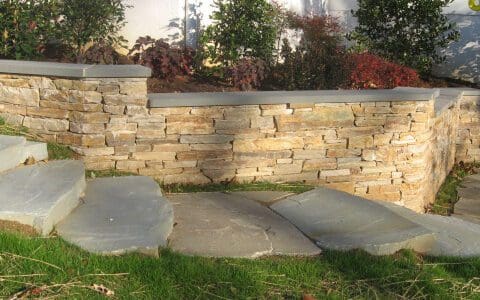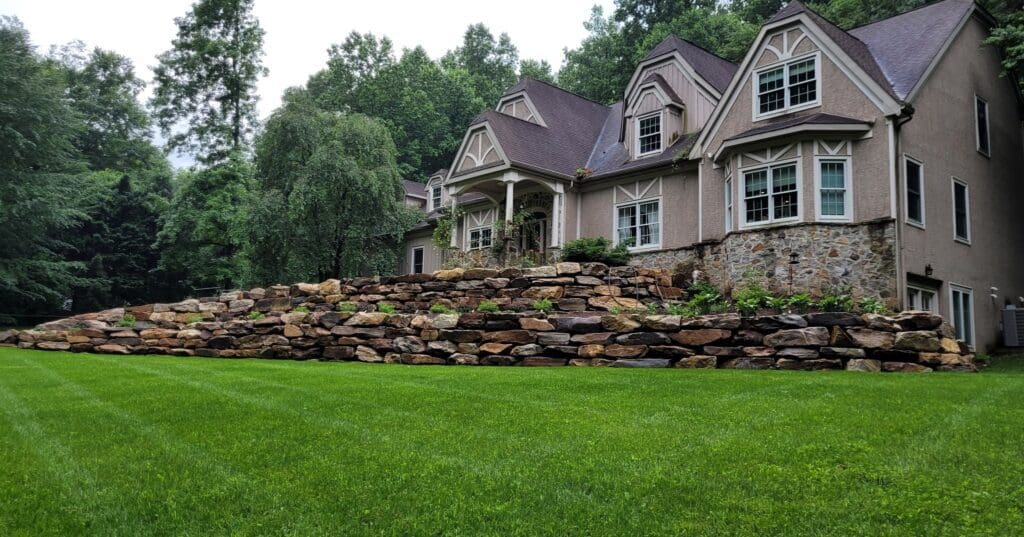Stone retaining walls are great additions to any home, providing aesthetic and practical benefits. An impressive feat of engineering, these structures can add beauty and value to the property.
Suppose you’re fortunate enough to own a home with a retained wall. In that case, you know what a joy it can be! These walls look great, add character, and perform an essential job in stabilizing soil, maintaining roadsides, and preventing erosion in gardens and other lower-lying areas.
But if you don’t have one, adding a stone retaining wall can be the perfect addition to any home. Let’s look at what you need to know about building and maintaining the perfect retaining wall.
What Is a Retaining Wall?
Retaining walls are structures that provide support by holding back soil or other types of material. They can prevent land erosion, level mulch and gravel embankments, or create outdoor spaces such as raised patio areas.
These walls can also be seen as key elements in landscape design as they offer clean lines and architectural beauty to gardens, walkways, and driveways.
No matter the look you’re going for, whether modern or traditional, they are an attractive way to add visual appeal and functionality to an outdoor space.
Performance of Various Types of Retaining Walls
Retaining walls come in all shapes and sizes and are typically crafted from stone, brick, cement, or timber.
Natural Stone Retaining Wall

First, you need to know about building a stone retaining wall. A stone retaining wall, also known as a rock retaining wall, is an architectural feature used to support soil laterally on a slope. They are usually made from locally sourced, naturally durable stones such as granite, marble, or quartzite formed into blocks interlocked by gravity.
Natural stone retaining walls can be built from various styles and materials. Still, the most popular design consists of cut blocks set in horizontally stacked layers, with the lower block having the most weight for maximum stability of the entire stone wall.
Choose smooth, flat stones if you want to sit on the wall. Or fill gaps with soil and fragrant plant herbs for cushions. We discussed these walls in detail in our “How a Stone Retaining Wall Will Notably Improve Your Home” blog.
Key Takeaways :
- Beautiful, classic appearance, incredibly strong, designed to stand for years with minimal maintenance.
- Larger-than-life rocks provide structure and stability to landscapes, as well as providing a touch of rustic charm.
- With proper care, it is long-lasting—on average from 60 to 100 years
Gravity Retaining Wall
Could you consider installing a gravity retaining wall when your landscaping project needs extra oomph? Gravity retaining walls are strong and built to last, designed to contain soil behind them and create an attractive feature in your landscape.
Constructed from interlocking blocks or stone masonry, these walls offer visual appeal and a practical solution for stabilizing slopes. Versatile in design, you can even layer different materials like timber, stone, or treated steel to create unique shapes and styles and make your outdoor space truly stand out!
Key Takeaways :
- Built to resist the lateral pressure of soil.
- It’s inexpensive for heights up to nine feet.
- Used to create terraces or other level areas in a landscape.
Dry Stack Retaining Wall
Dry stack retaining walls are a unique and sturdy solution to soil erosion, making them an excellent choice for homeowners who want to protect their property from the wear and tear of weather and time. They are usually constructed on a hillside but can be freestanding up to three feet.
These walls are unique because they are constructed with natural stone but without mortar. The stones are stacked on top of one another. This stacking method allows the retaining wall to be naturally draining, an important factor in retaining soil. The stones can also adjust to frost easily by shifting slightly.
Key Takeaways :
- Dry stack retaining walls are highly resistant to water erosion and other deterioration caused by weather or ground movement.
- The foundation for a dry stack retaining wall is leveled with crushed stone, which can also be used to fill in gaps.
- The three basic shapes of stone—round field stone, flat stacking stone, and uniformly cut stone—can be used for a dry stack retaining wall, giving your home a unique look.
Wood Panel Retaining Wall
A wood panel retaining wall is a common type of retaining wall made of wood panels. Wood panel retaining walls are typically made from treated lumber or other durable wood types resistant to rot and moisture.
The panels are attached to posts or other supporting structures and may be stacked on top of each other to create a solid, stable wall.
Wood panel retaining walls are frequently used in residential and commercial landscapes because they are relatively inexpensive, simple to maintain, and can be tailored to each project’s unique specifications.
Key Takeaways
- Wood panels retain moisture better than other materials, which can lead to rot
- Not as structurally sound as natural stone
Mechanically Stabilized Earth (MSE) Retaining Wall
Homeowners looking to increase their property value and security are turning to MSE retaining walls.
These structures provide a unique combination of engineering, physics, and construction, making them ideal for coastal areas, slopes, embankments, and all properties looking to maximize erosion control from extreme weather events.
Key Takeaways :
- Mechanically stabilized earth retaining walls are supported by granular fills and reinforced with metal strips or plastic meshes.
- MSE retaining walls offer a range of solutions, from temporary earth structures to concrete block and panel designs.
Other Retaining Wall Blocks
However, many other options are now on the market, such as:
- Interlocking concrete pavers
- Pre-cast concrete blocks
- Solid retaining wall
- Dry-stack retaining wall
- Cantilever retaining walls
- Hybrid retaining wall
Maintenance and Care of Stone Retaining Walls
While all types of retaining walls are designed to last a long time, natural stone retaining walls give you the most for your money. They last longer, provide greater support, and don’t degrade overtime like wood or concrete. With regular maintenance and care, you can extend the life of your stone retaining wall structure. Here are seven maintenance tips to help you start taking care of your retaining wall.
1. Inspect Your Wall Regularly
Homeowners should inspect their stone retaining walls at least once a year to look for signs of damage or deterioration. If you notice any cracks, bulging, or leaning, it’s essential to have a professional assess the situation as soon as possible, as these can be signs of a severe problem.
2. Remove Vegetation from the Base of the Wall
Remove any vegetation, such as trees, shrubs, or vines growing near the base of your retaining wall. The roots of these plants can damage the wall over time and cause it to lean or collapse.
3. Check for Drainage Problems
Another common cause of stone retaining wall failure is poor drainage. Make sure that there is no standing water near your wall and that any drains or gutters are clear and functioning correctly.
If you notice any pooling water, you should have a professional install a drainage system to protect your wall. However, if your wall is two stories high or more, it’s time to fill the space behind it with drainage gravel.
4. Repair any Cracks or Damage Immediately
Keep your retaining wall looking great! Issues like cracks and other damage tend to worsen if left untreated quickly, so it’s essential to address them as soon as you notice them. Even a seemingly small crack can quickly spread and become large enough to cause structural issues that could potentially be costly.
5. Fill in the Areas That Have Eroded
Keeping an eye on your stone retaining wall is a great way to prevent erosion, but sometimes, it’s unavoidable. This deterioration can occur over time due to ice damage, animal digging, and physical weathering.
If areas of your wall have become worn or eroded, the best solution is to fill them in with concrete and add a good amount of aggregate for stability. This will help you to repair any broken pieces or missing parts and protect against future erosion caused by temperature fluctuations and other elements.
6. Remove Any Mold And Mildew
Keeping an eye on your retaining wall is essential to prevent the long-term damage that mold and mildew can cause. After heavy rain, check in on your wall for any signs of moisture accumulation or leaks.
Power-washing or a mild bleach solution with a clear rinse afterward is the best way to keep your wall clean and free of mold and mildew.
7. Hire a Professional for Major Repairs or Replacements
If your stone retaining wall needs significant repairs or it’s ready for a replacement, it’s best to consult our team at Dutchies Stoneworks for this work. We will have the knowledge and experience necessary to complete the job.
Ready to Begin Building a Stone Retaining Wall?
Building a stone retaining wall is a popular choice for homeowners and businesses alike because of their functionality and aesthetic appeal.
At Dutchies Stoneworks, we’re proud to offer stone retaining walls as one of our many services. If you’re considering a stone retaining wall for your property, our team of experts would be happy to help you choose the perfect retaining wall for you and answer any questions you may have about the installation process. Get in touch with our team today to get started.

